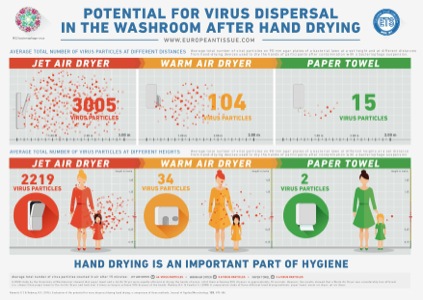

|
Chris Shaw
Editor |
| Home> | WASHROOM HYGIENE | >Hand Hygiene | >Hand drying with single-use towels 'least likely to spread viruses', study finds |
| Home> | FACILITIES MANAGEMENT | >Infection Control & Prevention | >Hand drying with single-use towels 'least likely to spread viruses', study finds |
Hand drying with single-use towels 'least likely to spread viruses', study finds
21 April 2016
New independent research has found that single-use paper towels are the most effective way to dry one’s hands in the washroom. The study indicates that they help minimise the spread of viruses including ones associated with various diseases, including those causing gastro-intestinal infections such as Norovirus and Rotavirus.

Details of the study will be revealed at ISSA/INTERCLEAN Amsterdam on 11th May at 14:00h in a talk entitled "Washroom hygiene: The dispersal of viruses by different hand-drying methods.”
According to the research, single-use towels disperse fewer microorganisms into the environment than jet air dryers and warm air dryers and also help reduce the risk that viruses are blown into the faces of small children accompanying adults in the washroom. The findings have serious implications for washroom facility managers in settings such as hospitals and restaurants where hygiene is paramount, the European Tissue Symposium says.
The research outcome
Leading microbiologists, Dr. Patrick Kimmitt and Keith Redway of the University of Westminster, studied the transmission of viruses using three different hand-drying methods: a jet air dryer, a warm air dryer and paper towels. The use of a jet air dryer was found to transmit more virus particles further and at different heights than the other methods, with airborne virus counts also significantly greater. At a range of heights tested, on average the jet air dryer produced over 60 times more viral plaques than a warm air dryer and over 1300 times more than paper towels. Combined average results at distances up to 3 metres away from the hand-drying devices showed that a jet air dryer produced over 20 times more viral plaques than a warm air dryer and over 190 times more than paper towels. Air samples collected 15 minutes after use showed that the jet air dryer produced over 50 times more viral plaques than a warm air dryer and over 100 times more than paper towels.
Viruses have been shown to survive on the hands for some time, with Influenza virus lasting from 10-15 minutes, Herpes virus for up to two hours, common cold virus up to one week, and Rotavirus for up to 60 days. Viral pathogens such as Norovirus have a low infectious dose and can be shed in large numbers in faeces.
“Our findings clearly indicate that single-use paper towels spread the lowest number of viruses of all the hand-drying methods we tested,” explained Dr. Patrick Kimmitt. “It is estimated that cross-infection contributes to 40% of cases of healthcare-associated infections and effective hygiene in hand washing and drying is an essential step in minimising such infections.”
Spreading the word
The study was presented briefly by Keith Redway at the European Public Health Conference in Milan in October 2015 where it received wide interest. It was subsequently published in a peer-reviewed scientific journal in December 2015 (reference: Kimmitt, P.T. & Redway, K.F. Evaluation of the potential for virus dispersal during hand drying: a comparison of three methods. Journal of Applied Microbiology. 120, 478-486. http://onlinelibrary.wiley.com/doi/10.1111/jam.13014/abstract).
Keith Redway will also present the results in full at ISSA/INTERCLEAN, Amsterdam on May 11th at 14:00h in a talk entitled ‘“Washroom hygiene: The dispersal of viruses by different hand-drying methods.”
“Good hand hygiene can save lives,” Keith Redway said. “Minimising infection risk by ensuring proper hand hygiene, includes understanding what may compromise that. Our research and results over the years have revealed time and again that single-use towels are the safest way to dry one’s hands in the washroom. This virus study delivers further proof that when it comes to hygiene, drying one’s hands with a single-use paper towel is the safest way to reduce the spread of viruses after a visit to the washroom.”
Previous research undertaken by the Universities of Leeds and Westminster has also found that jet air and warm air hand dryers can spread more bacteria and other microbes in a washroom environment than paper towels.
“Our industry places great emphasis on hygiene and studies have consistently shown that paper towels offer the most effective way to limit the spread of microbes in the washroom,” commented Roberto Berardi, chairman of the European Tissue Symposium. “This latest research not only focuses on viruses for the first time, but it was also undertaken by microbiological experts at the University of Westminster and thus serves to further underline our message. Although there are no official guidelines on proper hand drying hygiene, it is rewarding to see markets and industries turning to single-use towels again to avoid compromising hygiene standards in washroom facilities.”
http://europeantissue.com/hygiene/studies/hand-dryingsingleuse-towels/
- New information hub for hand hygiene
- Scientists prove paper towels are more hygienic than air blowing hand dryers
- ETS announces winners of cartoon contest
- Paper towels are more hygienic than other hand drying, study finds
- ETS to reveal new hand drying research at Eunetips & HIS Conference
- Sustainability is an integral part of the paper tissue value chain
- Why the choice of hand drying method in hospital washrooms should be a decision for infection control teams, not facilities managers
- ETS launches 4th international cartoon contest
- ETS launches hand hygiene competition
- GrittyFOAM Skin Safety Centre
- OxyBAC
- Developed to protect the US military – now fighting UK germs
- Better, Faster, Preferred: Introducing GrittyFOAM
- How to raise hand hygiene standards
- The POD – Reduce your paper consumption by up to 20%
- Barcode traceability
- Say goodbye to germs in the workplace
- UK office workers come clean over washroom hygiene and habits in new survey
- Weapon in war on superbugs





















